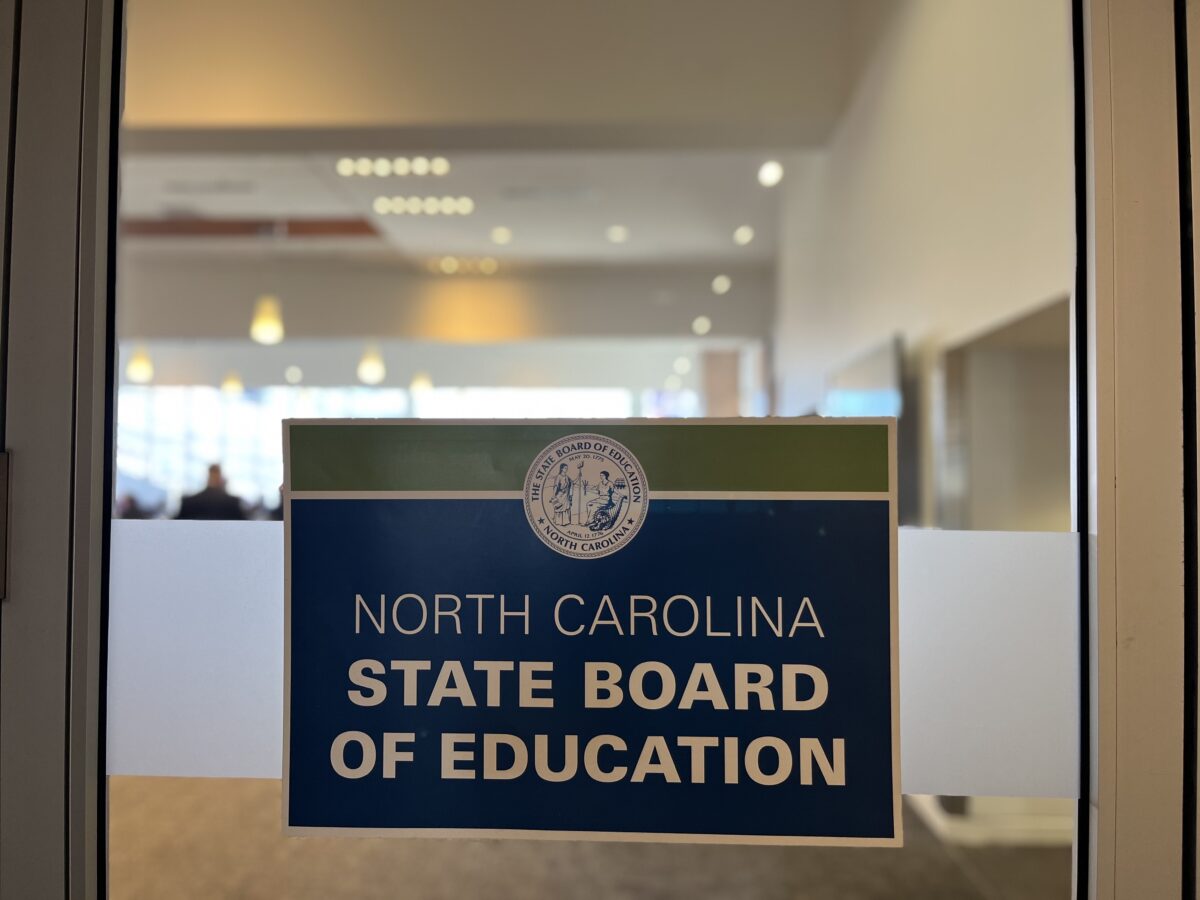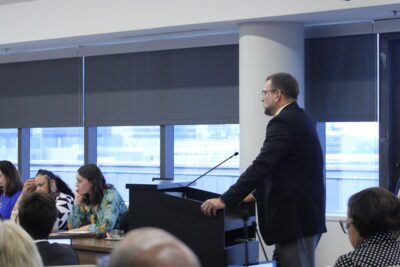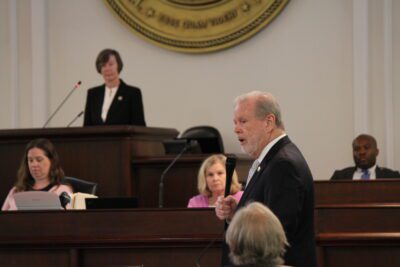
The State Board of Education’s virtual meeting on Thursday covered multiple topics, including policy amendments, a review of the Charter Schools Annual Report, and an update on cut scores for the edTPA exams.
To start, the Board welcomed three new advisors: Freddie Williamson, Superintendent of the Year from the Public Schools of Robeson County; Jason Johnson, Principal of the Year from Orange County Schools; and Rachel Candaso, Teacher of the Year from Pitt County Schools.
![]() Sign up for the EdDaily to start each weekday with the top education news.
Sign up for the EdDaily to start each weekday with the top education news.
No changes to edTPA cut scores
The Board voted not to raise the cut scores on the edTPA exams that teachers are required to pass for licensure. Cut scores are the minimum scores required to pass the assessment.
According to the Department of Public Instruction (DPI), raising the cut scores and increasing test attempts wouldn’t make a “significant difference in the effectiveness of those teachers.”
Thomas Tomberlin, senior director of DPI’s Office of Educator Preparation and Licensure, said that of test-takers who don’t pass on the first attempt, 57% don’t take the test again.
“Raising the cut score would increase the number of failures, and therefore we would have to predict that the majority of those that fail would go on to never attempt the test and complete the test,” Tomberlin said. “Repeated attempts at this do not yield positive outcomes. They generally lead to abandonment of the requirement.”
In North Carolina, 74% of test-takers pass on the first attempt. After the first attempt, the passing rate hovers between 82% and 85%. Increasing the cut score from 38 to 39 would lower the expected pass rate by 3.9 percentage points, impacting an expected 856 candidates.

Seeing a significant impact on student growth would require raising the cut score to 44, Tomberlin said.
The Board voted to keep the cut scores as they are, as DPI and the Professional Educator Preparation and Standards Commission, which works to reform teacher licensure and pay in North Carolina, both recommended.

Updates to athletics manual ban transgender athletes
The Board also heard from Brad Alford, director of the Office of Athletics at DPI, and approved changes to the North Carolina’s middle and high school athletics manual. Included in the changes is an eligibility update effectively banning transgender athletes’ participation in middle and high school sports. The change aligns the manual with G.S. 115C-407.59, which became law in 2023 after Republican lawmakers overrode former Gov. Roy Cooper’s veto.
The manual requires teams to be “designated by the biological sex of the participants.” The new language states:

“They do have the option that if a girls team is not offered, then girls can play with the boys, but under no circumstances can the boys play on a girls team,” Alford said.
The manual, which will be sent to districts before the 2025-26 school year, also removed gymnastics and replaced it with lacrosse, and added new weight classes for girls wrestling.
A review of the charter schools annual report
The North Carolina Office of Charter Schools presented the Charter Schools Annual Report to the Board. The 12-member Charter School Review Board (CSRB) unanimously voted to approve the report at its June meeting.
Read EdNC’s coverage of the CSRB’s June meeting and annual report here.
Ashley Baquero, the executive director of the Office of Charter Schools, said the state’s 208 operating charter schools serve more than 153,000 students.
“If we were to look at the total charter school enrollment of over 150,000 students as a district, there would be only one other larger district in the entire state, and that would be Wake County,” Baquero said.
She said 161 North Carolina charter schools report having a waitlist, totaling over 74,000 students statewide, though some of those students could be duplicates. While two new charter schools opened this year, five closed, and nine more are expected to open this fall.
Charter school demographics are changing, which Baquero said indicates a shift to a more “diverse student body.” Despite a drop in enrollment, white students continue to be overrepresented in charter school enrollment, and Black student enrollment has remained steady. While Hispanic student enrollment has grown, Baquero said Hispanic students are still underrepresented in North Carolina charter schools.

The Office of Charter Schools conducted a survey and found five common challenges for schools.
- 53.8% struggle with teacher retention and recruitment,
- 42.6% report general budget concerns,
- 38.6% consider academic needs and learning loss recovery a challenge,
- 35.9% have facility concerns, and
- 35.9% struggle with staffing and funding for Exceptional Children.
In 2023-24, 68% of charter schools in North Carolina earned A, B, or C performance grades. Another 70% met or exceeded growth.
Update on DPI’s strategic plan
The Board also provided an update on DPI’s strategic plan on Thursday. The first draft of the plan was announced at the Board’s June meeting. Since then, the Strategic Planning Committee has gathered feedback from stakeholders across the state. Superintendent of Public Instruction Maurice “Mo” Green previously went on a statewide listening tour to develop his strategic plan for DPI.
The committee will review the feedback and refine the plan for the rest of July, with a goal of presenting the final draft of the plan at the August Board meeting.
Board Member Olivia Oxendine expressed concern over “duplicated areas” in the plan and concerns that some issues in the plan — like school suspensions — are better addressed by school districts, not the state.
Green welcomed the feedback.
“There are things that we will be doing to refine it, improve it, improve language, try to remove duplication,” Green said. “We will certainly go back and look at the draft with that lens to be sure that we are addressing the issues from the appropriate level and saying, ‘This is what we want to happen, and this is where DPI, state board can have an impact.’”
Update on remote academies
The Board also heard updates on remote academies, 25 of which submitted updates to their applications. Updates vary in the following ways:
- Number of Changes Related to Curriculum – 8
- Number of Changes Related to Grade Levels – 16
- Number of Changes Related to Enrollment – 20
- Number of Changes Related to Administrator – 14
- Number of Changes of Full Virtual/Face Virtual – 9
There are 34 remote academies in North Carolina. In North Carolina, remote academies are public schools “whose instruction is provided primarily online through a combination of synchronous and asynchronous instruction delivered to students in a remote location outside of the school facility.”
The Board highlighted a recent regional collaboration between Rowan-Salisbury Schools and Stanly County Schools, which allows the districts to share instructional services while maintaining local oversight. The partnership has allowed Stanly County Schools to expand its remote offerings to serve K-12 students.

Important K-12 legislative issues
Geoff Coltrane, senior director of government affairs and strategy for the Office of Government Affairs, provided the Board with legislative updates.
With no budget passed, the General Assembly went on a break on June 26. The House and Senate each proposed mini-budgets before the break, though neither passed both chambers.
Coltrane reviewed 10 bills with the Board that would affect K-12 education:
- SB 254: Charter School Changes
- HB 832: Education Omnibus
- HB 378: Various Ed Law/Tax Acct/NIL Changes
- HB 959: Various Education Changes
- SB 77: School Contracted Health Services
- SB 600: Improve Health and Human Services
- SB 227: Eliminating “DEI” in Public Education
- HB 775: Criminal History Checks for School Positions
- SB 449: Fisc Resp & K-20 Tech Plan/Centr Offic Salary
- HB 1012: Disaster Recovery Act of 2025
SB 254, which was vetoed by Gov. Josh Stein on July 2, would have transferred power from DPI and the state superintendent to the CSRB. HB 832 is the education omnibus bill that originally would have expanded how school safety grant funds could be used, but now includes several other provisions.
Green and Board Chair Eric Davis previously expressed concern about SB 254 and HB 832.
Science standards, school nutrition, and healthy learning environments
- The Board also heard updates on the United States Department of Agriculture’s Fresh Fruit and Vegetable Program, which provides $6,249,315 to the Office of School Nutrition for distribution among 225 school districts. Based on school enrollment, the allotment is between $50 and $75 per pupil. The program prioritizes school districts with the highest percentage of economically disadvantaged students.
- The Board approved $3.7 million in funding from the North Carolina Stronger Connections Grant to be distributed among 13 school districts. The grant comes under the Bipartisan Safer Communities Act, which aims to “provide students with safer and healthier learning environments.”
- Updates were given on the Community Eligibility Provision Meal Program Incentive. DPI estimated that 48,550 students at 157 participating schools are eligible for the program, which means they can receive breakfast and lunch at school at no cost.
The full Board meets next Aug. 6-7.
Recommended reading



